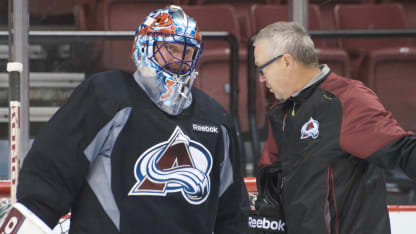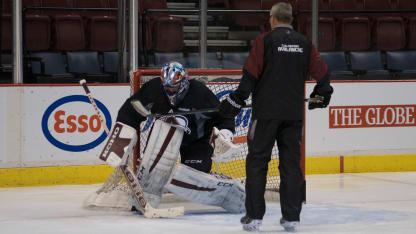VANCOUVER -- Watching Colorado Avalanche coach Patrick Roy back in goalie gear and on the ice with long-time goaltending coach Francois Allaire was like being granted access to a time machine, a window into the evolution of the position.
Together since Roy's rookie season with the Montreal Canadiens in 1986, they changed the goaltending position forever by making the butterfly save a standard the rest of the world still uses as a staple 30 years later. Three decades and five Stanley Cups later (two together in Montreal, two for Roy in Colorado and one for Allaire while coaching the Anaheim Ducks), the most important teacher-student relationship in the history of goaltending was rekindled Sunday to help Roy prepare to play in the 2016 Coors Light NHL Stadium Series Alumni Game against the Detroit Red Wings at Coors Field on Friday.
Roy, Allaire get back to work
Times and techniques have changed, but Hall of Fame goaltender's drive hasn't

"I've been working pretty good at it; I won't say extremely hard, but it's been fun," Roy said. "There's things that have changed, especially on the bad-angle shots, and for me it's an adjustment, but it is fun to work with him."
Watching Roy on the ice again, it's clear a lot has changed in the 13 years since he retired. He and Allaire may have revolutionized the position when they went against the stand-up style predominant in the mid-1980s, dropping to the ice instead with the pads flared to either side to prioritize taking away the bottom of the net, but even by the time Roy finished playing in 2003 there were new elements emerging he hadn't added.
"Especially situations coming from bad angles," Roy said. "I used to be more butterfly kind of goalie and now they are one-knee down, or they try to take away the short side with their upper body. Things have changed and you try to adapt."
Seeing Roy and Allaire together at a recent game-day skate, it was easy to envision similar sessions 30 years ago; back-and-forth conversations that shaped how the position is played. They huddled near the crease after drills, with Allaire pointing out various spots in the offensive zone as they worked through the modern post-integration options Roy mentioned, and helped him learn how to transition out of those positions with butterfly slides, something he didn't do a lot of when he played.
"Obviously that's a lot of fun, you remember a lot of good souvenirs, I guess," Allaire told NHL.com of working with Roy in the crease again. "Patrick wants to know the new way to stop the puck and was asking questions about 'how should I do that play? How are the guys doing that today?' So it's a little bit of teaching still, but at the same time it's a lot of fun, a lot of smiles on the face, and I am really enjoying these moments."
Roy didn't think the position "changed that much" since he retired, pointing to staples like covering angles, reading plays and moving well side-to-side as constants, but some of the ongoing evolution was evident in simple movements as he took shots from Avalanche players. The 50-year-old still dropped to the ice in that familiar butterfly, but his movements out of it almost always involved getting back up to his skates first, and he often started with the wrong leg.
That wasn't uncommon in the NHL when Roy retired, but even back then, when so many of the game's best were still getting up on the incorrect leg, almost all young goaltenders were already being taught proper-leg recovery mechanics: Getting up with the leg opposite of the direction they needed to go next, thereby establishing a push edge earlier.
It wasn't uncommon back then to hear NHL goalies talk about seeing 12-year-olds at summer camps and realizing the kids were already more technically sound than they were.

Now those 12-year-olds are in their mid-20s, and the technical habits that were ingrained early are a big part of what Allaire labeled a golden age for goaltending coaches.
"Our athletes are better so it's way easier now," said Allaire, who at age 56 is only six years older than Roy. "The kind of drills we can do today are drills we couldn't do in the '80s and '90s. The goalies were not ready, their mind was not ready for that, but now the kids are coming into the League are ready to do whatever it takes and they have the capacity to do it, which is different. They are way bigger, way stronger, and well trained, so it's a golden era for the goalie coach right now because there are so much good athletes available. It's incredible the level of goaltending right now."
Mindsets have also changed, Allaire said. There is less resistance now than what he experienced as the first goalie coach in the history of the Canadiens.
"You can really push in the right direction with these guys and their mind is really open for making changes," he said. "It's a new generation of guys, where when I came in this business in the '80s everything was static, everything was really, really rigid and there was no place for improvement, no place for changes, and now it's at the other end. We have young kids coming and whatever you say they are ready to try it."
Allaire, who became the Avalanche goalie coach soon after Roy took over as coach in 2013, believes the constant evolution of the position is fueled by technology.
"It's changing a lot right now for one reason: the Internet," Allaire said. "We used to do different things, Patrick and me, when we started in the '80s, and we can stay four or five years doing something new and no one notices. Now if something is new in the business, a couple months after you can see it and everybody can teach it. So it's a different world, it's a different game of hockey, which is fun because you have to be up to date all the time."
For all the technical innovations he was a part of, it was Roy's fierce competitiveness that fueled a first-ballot Hall of Fame career that included three Conn Smythe and Vezina trophies. That still shone through as he dove head first across the crease to rob one of his young Avalanche forwards during that recent practice session, abandoning the technique he has become synonymous with and doing whatever he could to keep the puck out of the net.
"That's still in his blood, it's part of his make up to compete on every shot," Allaire said.

















